Frans Pourbus the Elder (circa 1545–1581) stands as a significant figure in the rich tapestry of Flemish art during the latter half of the sixteenth century. A prominent member of a distinguished artistic dynasty, he carved out a notable career primarily in Bruges and Antwerp, the bustling artistic and commercial centers of the Southern Netherlands. His oeuvre, though sometimes overshadowed by that of his equally famous son, Frans Pourbus the Younger, is characterized by a refined realism, particularly in portraiture, and a thoughtful engagement with religious and allegorical themes. Pourbus the Elder's work provides a fascinating window into the artistic currents of his time, reflecting a transition from the late Gothic traditions of early Netherlandish painting towards the burgeoning influences of the Italian Renaissance, a style often referred to as Romanism in the North.
Early Life and Artistic Lineage in Bruges
Frans Pourbus was born in Bruges around 1545, into a family already steeped in artistic tradition. His father was Pieter Pourbus (circa 1523–1584), one of Bruges' leading painters and cartographers of his generation. Pieter himself was a versatile artist, known for his meticulously detailed portraits, grand religious compositions, and innovative allegorical works like the "Allegory of True Love." He also played an active role in the civic life of Bruges, undertaking commissions for maps and decorations that showcased his diverse talents. Growing up in such an environment, young Frans would have been immersed in the sights, sounds, and practices of a busy painter's workshop from his earliest years.
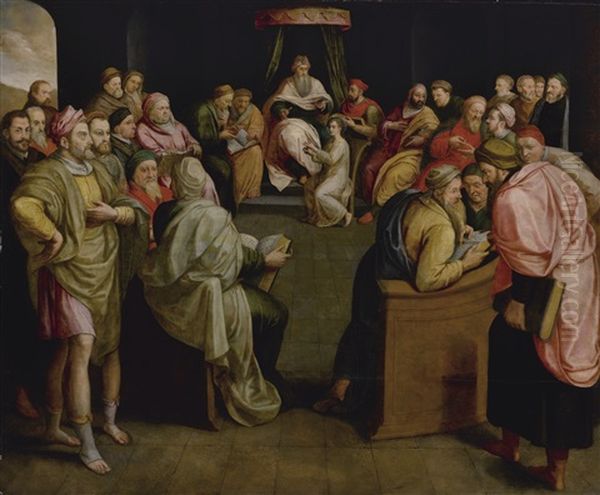
The artistic atmosphere of Bruges, though perhaps past its absolute zenith of the fifteenth century when masters like Jan van Eyck and Hans Memling made it a beacon of European art, still retained a strong tradition of craftsmanship and artistic innovation. Pieter Pourbus had himself been a pupil of Lancelot Blondeel, a painter, architect, and designer known for his elaborate style. This lineage provided Frans with a solid grounding in the technical and aesthetic principles of Flemish painting. His initial training undoubtedly took place under his father's direct tutelage, where he would have learned the fundamentals of drawing, paint preparation, composition, and the meticulous rendering of textures and details that were hallmarks of the Bruges school.
This early exposure to his father's diverse practice – from intimate portraits of the local bourgeoisie and clergy to large-scale altarpieces and civic commissions – would have provided Frans with a comprehensive artistic education. He would have observed firsthand the process of negotiating commissions, managing a workshop, and adapting artistic style to suit various patrons and purposes. This foundational period in Bruges was crucial in shaping his technical proficiency and his understanding of the painter's role in society.
Apprenticeship in Antwerp and the Influence of Frans Floris
To further his artistic development and engage with the most current artistic trends, Frans Pourbus the Elder moved to Antwerp, which by the mid-sixteenth century had surpassed Bruges as the primary economic and artistic hub of the Low Countries. In Antwerp, he entered the workshop of Frans Floris de Vriendt (circa 1519/20–1570), one of the most influential painters of the Flemish Renaissance and a leading proponent of Romanism. Floris had traveled to Italy, studying the works of masters like Michelangelo, Raphael, and Tintoretto, and upon his return to Antwerp, he established a large and highly productive workshop that disseminated Italianate ideals throughout the Netherlands.
Frans Floris's studio was a veritable academy, attracting ambitious young artists from across the region. Here, Pourbus would have been exposed to a style that emphasized anatomical accuracy, dynamic compositions, and a more monumental treatment of the human figure, all inspired by Italian High Renaissance and Mannerist art. Floris was renowned for his large-scale historical and mythological paintings, which contrasted with the more intimate and detailed style prevalent in traditional Flemish painting. The experience in Floris's workshop was transformative for Pourbus, broadening his artistic horizons and equipping him with a more sophisticated and internationally informed visual language.
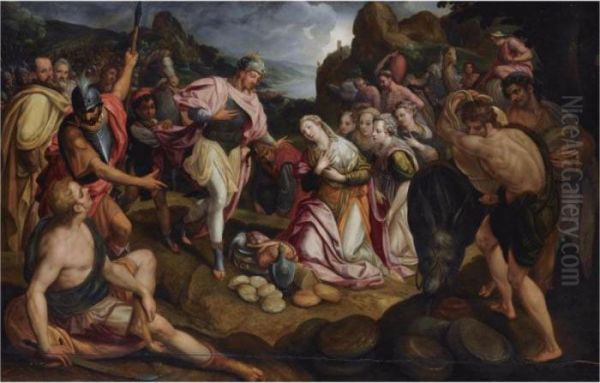
Among his fellow students and collaborators in Floris's workshop were figures who would also go on to have significant careers, such as Marten de Vos, Ambrosius Francken I, and Crispin van den Broeck. This environment fostered a spirit of learning and emulation, as artists absorbed Floris's teachings and adapted them to their own sensibilities. Pourbus, while embracing the monumentality and idealized forms of Romanism, retained a strong Flemish inclination towards realistic detail and psychological acuity, particularly evident in his portraiture. His time with Floris was pivotal, allowing him to synthesize the strengths of both the native Flemish tradition and the imported Italianate style.
In 1569, Frans Pourbus the Elder married Suzanna Floris, the niece of his master Frans Floris and daughter of Cornelis Floris II, a renowned sculptor and architect. This union further solidified his connections within the prominent artistic circles of Antwerp.
Career and Recognition in Antwerp
Frans Pourbus the Elder was officially enrolled as a master in the Antwerp Guild of Saint Luke in 1564. Membership in the guild was essential for any artist wishing to practice independently, take on apprentices, and sell their work within the city. This marked his formal entry into the professional art world of Antwerp. He quickly established a reputation as a skilled painter, particularly sought after for his portraits, though he also continued to produce religious and, to a lesser extent, genre and historical scenes.
His patrons likely included the affluent merchants, city officials, and members of the nobility who constituted Antwerp's elite. The city's thriving international trade and financial markets created a wealthy class eager to commission artworks that reflected their status and piety. Pourbus's ability to render likenesses with precision, combined with a dignified and often insightful portrayal of his sitters' character, made his portraits highly desirable. He captured not only the external appearance but also a sense of the individual's presence and social standing, often through the meticulous depiction of luxurious fabrics, intricate jewelry, and symbolic attributes.
While portraiture formed a significant part of his output, Pourbus also undertook religious commissions. These works often show the influence of Frans Floris in their compositional structures and figure types, but they also retain a Flemish clarity and emotional directness. The religious climate of the time was complex, with the ongoing tensions of the Reformation and Counter-Reformation impacting artistic production. Artists like Pourbus navigated this landscape, producing works that could appeal to various devotional sensibilities.
His career in Antwerp, though relatively short due to his early death, was productive. He successfully ran his own workshop, likely employing assistants and training apprentices, including, most notably, his own son, Frans Pourbus the Younger, who would go on to achieve even greater international fame as a court painter.
Artistic Style: A Synthesis of Traditions
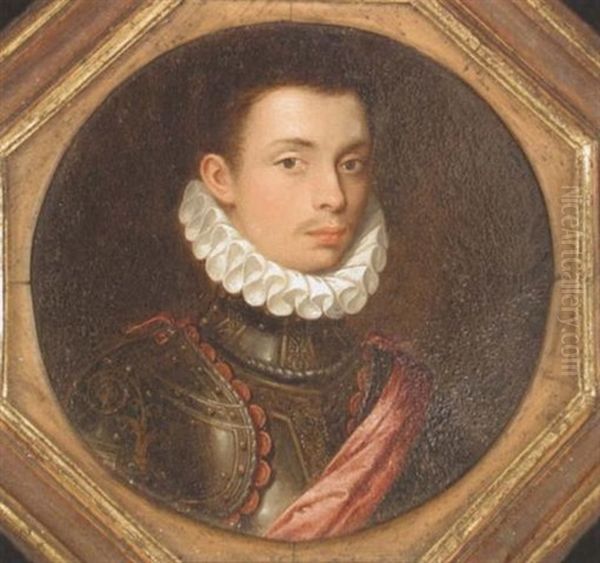
Frans Pourbus the Elder's artistic style is best understood as a skillful amalgamation of the indigenous Netherlandish tradition and the Italianate influences he absorbed, primarily through Frans Floris. From the Flemish heritage, particularly masters like Jan van Eyck and Rogier van der Weyden, he inherited a commitment to meticulous detail, a rich use of oil glazes to achieve depth and luminosity of color, and a keen observation of surface textures. This is especially evident in the rendering of fabrics, fur, metal, and jewelry in his portraits, where every element is depicted with painstaking care.
The influence of Romanism, championed by Floris, introduced a greater sense of monumentality and idealization to his figures. While his portraits remained grounded in realistic observation, his religious and allegorical figures often display more robust musculature and dynamic poses reminiscent of Italian High Renaissance art, particularly the works of artists like Raphael and Michelangelo, whose styles Floris had emulated. However, Pourbus rarely adopted the more exaggerated contortions of extreme Mannerism, preferring a more balanced and harmonious approach.
In his portraiture, Pourbus excelled at capturing not just a physical likeness but also a sense of the sitter's personality and social standing. His subjects are often presented with a direct gaze, engaging the viewer with a quiet intensity. He paid close attention to the hands, often a key indicator of character and status, and used costume and accessories to convey wealth and identity. His compositions are typically well-balanced, with the figure often placed against a neutral or subtly detailed background that does not detract from the sitter. His palette is generally rich and sober, with a sophisticated use of blacks, reds, and earth tones, enlivened by carefully placed highlights. He can be compared to other Netherlandish portraitists of the era, such as Anthonis Mor (Antonio Moro), who also achieved international renown for his dignified and psychologically astute portrayals of European nobility.
His religious works, while less numerous or perhaps less studied than his portraits, demonstrate his ability to handle complex multi-figure compositions and convey narrative with clarity. Works like "Christ Among the Doctors" or the altarpiece "Christ Heals the Sick" (though attribution for the latter can sometimes be debated or confused with his father's work) showcase his capacity for dramatic storytelling within a framework that blends Flemish realism with Italianate compositional devices.
Notable Works and Commissions
Identifying and definitively attributing all works by Frans Pourbus the Elder can sometimes be challenging due to the existence of his father, Pieter, and his son, Frans the Younger, both accomplished painters. However, several key works are generally accepted as his and exemplify his style.
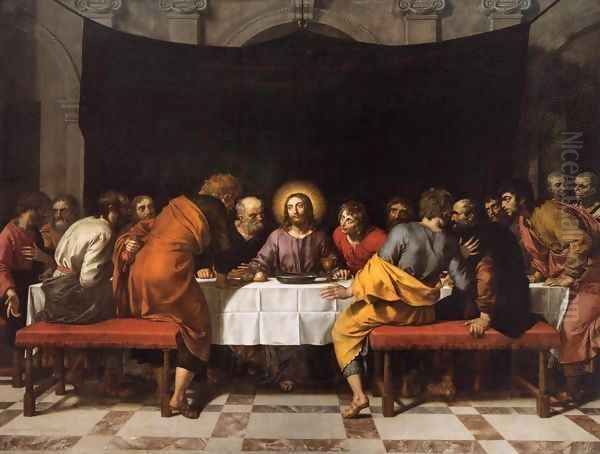
Among his most celebrated portraits are those of the Hoefnagel family. Joris Hoefnagel was a prominent cartographer, miniaturist, and merchant, and Pourbus painted several members of his family. These portraits are characterized by their refined execution, sensitive portrayal of character, and meticulous attention to detail in costume and setting. For example, the "Portrait of a Man with a Dog" (often identified as a member of the Hoefnagel family) showcases his skill in rendering textures, from the soft fur of the dog to the crisp ruff and dark fabric of the sitter's attire.
Religious compositions also feature in his oeuvre. The "Viglius Aytta Triptych," depicting the Last Supper flanked by portraits of Viglius van Aytta, a prominent statesman, and his family, is a significant work often attributed to him or his circle, demonstrating the integration of portraiture within a religious context, a common practice in Netherlandish art. Another example is "David and Abigail," which showcases his ability to handle narrative scenes with a degree of dynamism and emotional expression, reflecting the Romanist influence.
Many of his portraits are of unidentified sitters, typical of the period, where the identity of the subject was known to the commissioner but not always recorded for posterity. These anonymous portraits nevertheless stand as testaments to his skill, capturing the essence of the Flemish and Antwerp bourgeoisie and minor nobility of the late sixteenth century. Each face tells a story, rendered with an honesty and precision that makes these individuals from centuries past feel remarkably present.
The demand for such portraits was high in prosperous Antwerp, a city teeming with wealthy merchants, guild members, and civic leaders who wished to commemorate themselves and their families. Pourbus catered to this market with an artistry that combined traditional Flemish craftsmanship with a more modern, slightly Italianate elegance.
Contemporaries and the Artistic Milieu of Antwerp
Antwerp in the mid-to-late sixteenth century was a vibrant and competitive artistic center. Frans Pourbus the Elder worked alongside a host of talented painters, sculptors, and printmakers. His master, Frans Floris, was a dominant figure, but other notable artists also shaped the city's artistic landscape.
Pieter Bruegel the Elder (c. 1525–1569), though stylistically distinct with his focus on peasant life and panoramic landscapes, was a contemporary whose innovative work also contributed to Antwerp's fame. While Pourbus focused more on portraiture and traditional religious themes with a Romanist inflection, Bruegel explored different facets of human experience and the natural world.
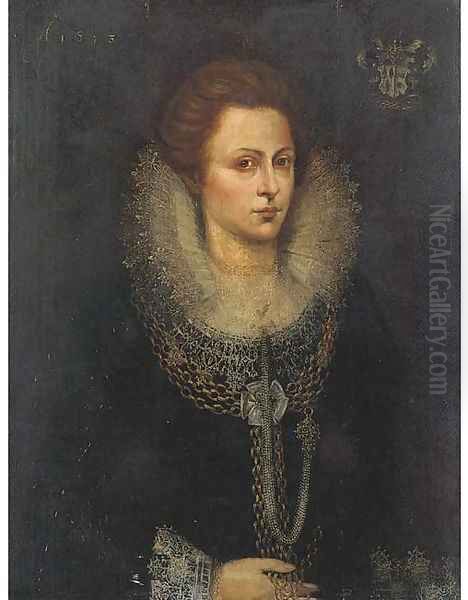
Marten de Vos (1532–1603), a fellow Romanist who also likely spent time in Floris's studio and traveled to Italy (studying with Tintoretto), was another prominent contemporary. De Vos was highly prolific, producing numerous altarpieces, mythological scenes, and designs for prints. His style, like Pourbus's, blended Italianate grandeur with Flemish detail.
Ambrosius Francken I (1544–1618) and Hieronymus Francken I (c. 1540–1610) were part of another significant Antwerp painting dynasty. They, too, were influenced by Floris and produced a wide range of works, including religious and historical subjects. Crispin van den Broeck (1523–c. 1591), who had been a fellow student in Floris's workshop, also became an independent master known for his religious paintings and designs for engravings. He is noted by some sources as having helped complete some of Floris's unfinished works after the master's death in 1570, a task in which Pourbus the Elder might also have participated given his close ties.
Other artists active in Antwerp during this period included Gillis Coignet, known for his nocturnal scenes and religious paintings, and the landscape specialist Gillis van Coninxloo. The printmaking industry, led by figures like Hieronymus Cock and later the Galle family and Christophe Plantin's publishing house, was also booming, disseminating artistic ideas and images across Europe. This dynamic environment, with its guilds, workshops, and international clientele, provided both opportunities and challenges for artists like Pourbus. He had to distinguish himself through the quality and particular appeal of his work.
The period was also marked by significant religious and political upheaval. The Beeldenstorm (Iconoclastic Fury) of 1566 saw the destruction of much religious art, and the subsequent Eighty Years' War (1568–1648) created an unstable environment. Despite these challenges, artistic production continued, often adapting to changing patronage and devotional needs. For instance, the Counter-Reformation spurred a demand for new altarpieces and religious imagery that adhered to the Council of Trent's decrees.
The Pourbus Artistic Dynasty
Frans Pourbus the Elder was a key link in a notable artistic dynasty that spanned at least three generations. His father, Pieter Pourbus, established the family's artistic reputation in Bruges. Frans the Elder built upon this foundation, achieving success in the more competitive environment of Antwerp.
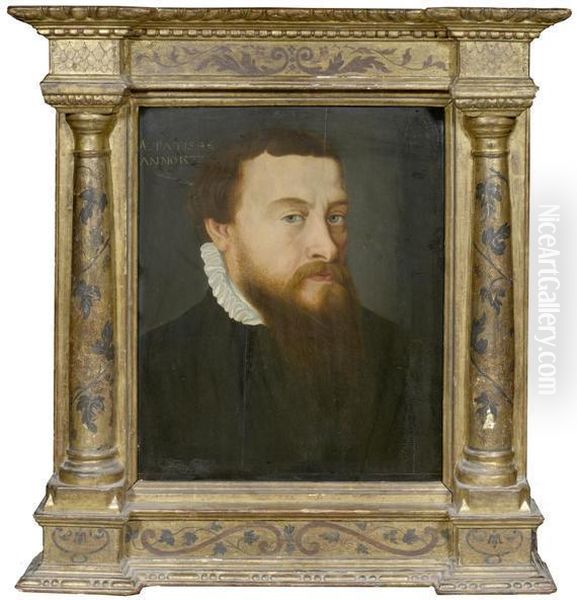
His most famous successor was his son, Frans Pourbus the Younger (1569–1622). Born in Antwerp, Frans the Younger initially trained with his father. However, Frans the Elder died when his son was only about twelve years old. It is believed that Frans the Younger may have subsequently completed his training with other masters, possibly even Otto van Veen, who was also a teacher of Peter Paul Rubens. Frans the Younger went on to have a distinguished international career, serving as a court painter to Vincenzo Gonzaga, Duke of Mantua (where he worked alongside Rubens), and later to Marie de' Medici, Queen of France, in Paris. His style evolved towards a more polished, international courtly Baroque, distinct from his father's, yet still rooted in the Flemish tradition of meticulous observation.
The existence of multiple artists named Pourbus has sometimes led to confusion in attributions, particularly between Pieter, Frans the Elder, and Frans the Younger. Careful stylistic analysis and documentary research are often required to distinguish their hands. Frans the Elder's work generally occupies a stylistic space between the more robust, locally rooted art of his father and the more refined, internationally oriented art of his son.
A grandson, Frans Pourbus III, is also recorded as a painter, though he is a more obscure figure and his artistic contributions are less well-documented, suggesting the dynasty's prominence in painting largely concluded with Frans the Younger.
Untimely Death and Legacy
Frans Pourbus the Elder's promising career was cut short by his premature death in Antwerp in 1581, at the age of only about 36. The exact cause of his death is not widely recorded, but it occurred during a period of turmoil in Antwerp, including an outbreak of the plague (sometimes referred to as "het zweet" or sweating sickness). His passing left his young son, Frans the Younger, to carry on the family's artistic legacy. Had he lived longer, Frans Pourbus the Elder might have achieved even greater renown and further developed his style, potentially playing a more direct role in the transition towards the Flemish Baroque.
Despite his relatively brief career, Frans Pourbus the Elder made a significant contribution to Flemish art of the sixteenth century. His portraits are valued for their psychological insight, technical refinement, and as historical documents of the individuals who shaped society in Bruges and Antwerp. He successfully navigated the stylistic currents of his time, creating a body of work that is both representative of its era and possessed of a distinct personal quality.
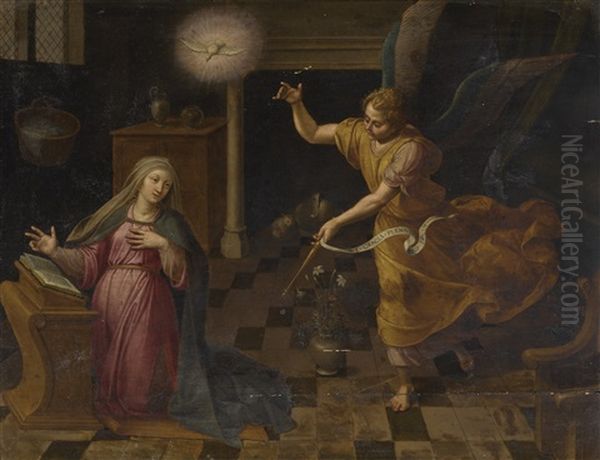
His influence can be seen in the early training of his son, who absorbed the fundamentals of portraiture and technique that would serve him well in his international career. More broadly, Pourbus the Elder's work exemplifies the quality and sophistication of Antwerp painting in the period before the full flowering of the Baroque under masters like Rubens, Anthony van Dyck, and Jacob Jordaens. He stands as a testament to the enduring strength of the Flemish tradition of realism, even as it engaged with and adapted to new influences from Italy.
His paintings are now held in major museums and collections around the world, including the Groeningemuseum in Bruges, the Royal Museums of Fine Arts of Belgium in Brussels, the Rijksmuseum in Amsterdam, the Louvre in Paris, and the Metropolitan Museum of Art in New York, allowing contemporary audiences to appreciate his skill and artistry.
Conclusion: An Enduring Contribution to Flemish Art
Frans Pourbus the Elder occupies an important, if sometimes underappreciated, place in the history of Flemish art. As a scion of an artistic family, he inherited a strong technical foundation which he enriched through his training with Frans Floris, a key figure of Antwerp Romanism. His career, though tragically brief, was marked by a successful practice in portraiture and religious painting, serving the discerning clientele of Bruges and, more significantly, the bustling metropolis of Antwerp.
His artistic signature lies in the harmonious blend of traditional Flemish meticulousness – the detailed rendering of textures, the subtle play of light, and the acute observation of individual physiognomy – with the more monumental forms and compositional sophistication inspired by the Italian Renaissance. His portraits, in particular, offer compelling glimpses into the lives and personalities of his sixteenth-century sitters, capturing their status and character with dignity and insight. He was a contemporary of giants like Pieter Bruegel the Elder and worked in an environment that included influential figures such as Marten de Vos and Ambrosius Francken I.
While his son, Frans Pourbus the Younger, would go on to achieve greater international fame in the courts of Italy and France, the elder Pourbus laid a crucial part of the foundation for this success. His work represents a vital link in the chain of Flemish artistic development, bridging the gap between the earlier Netherlandish masters like Jan Gossaert or Bernard van Orley, who also engaged with Italianism, and the full-blown Baroque era. Frans Pourbus the Elder's legacy endures in his surviving works, which continue to be admired for their technical brilliance, their quiet intensity, and their faithful reflection of the individuals and the artistic currents of a pivotal period in European art history.